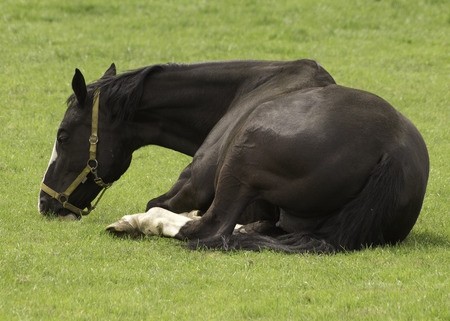By Dr. Jeffrey Moss, DVM
“Doctor, I think my horse is colicky. What should I do?” This is the familiar phone call that all equine veterinarians have gotten and will continue to get as long as they are practicing. Colic in horses is a very common ailment but also one that can be very serious. It is not something to take lightly. Fortunately most colic’s resolve with minimal medical treatment. However there are some that need surgical intervention.
What is colic? Colic is a general term for abdominal pain in a horse. Colic can be caused by a number of things. Some of those include: Gas, impaction, sand, gastric ulcers, enteroliths or stones, torsion of the colon, entrapped small intestine, strangulated intestine, enteritis (inflammation of the intestine) or unknown reasons. No matter what the cause, many of the signs that horse owners will see are the same. It is difficult to distinguish between a medical colic, and a surgical colic just by looking at the horse. That is why it is important to address the colic symptoms as soon as you see them.
Some of the common behaviors exhibited by colicky horses include but are not limited to: not eating, lying down, rolling, pawing at the ground, or looking back at the abdomen. Most horses love to eat. If there is food they will eat. So when you see your horse that is always interested in food all of a sudden is not interested in food you need to ask yourself, “What is wrong?” Along with not eating, a colicky horse is often found lying down on the ground. Now some horses are known to take naps, but most horses are up during the day. So when you notice different behavior such as lying down during the day you may have a problem. If the horse does not get up right away, or gets up and then immediately goes right back down the horse may be suffering from colic.
Along with the clinical signs of pawing, rolling and not wanting to eat, horses with colic will often times have an elevated heart rate due to abdominal pain. Horses suffering from colic rarely have a fever. So if your horse does have a fever (anything over 101.5 F. ) the colic is probably secondary to something else.
The horse’s GI tract is very unique in a lot of ways. It also predisposes horses to colic.
Once food has been chewed, it passes down the esophagus into the stomach. The horse has a fairly small stomach for its size (about 2 gallons). After a period of digestion in the stomach, food passes into the small intestine. This part of the gut is approximately 66ft in length, with a diameter of 3-4 in. The majority of the small intestine hangs from a curtain-like membrane called the mesentery. The mesentery is attached to one point in the middle of the abdomen, under the spine. (The small intestine looks like a very long sausage running along the bottom of the mesentery, with the top of the curtain all bunched together.)
At the junction of the small and large intestines the equine GI tract has a large blind-ended out pouching over 3 feet long with a capacity of 6-7 gallons. This is the cecum (the horse’s version of our appendix). Food passes from the small intestine into the cecum before passing into the large intestine. Together, the cecum and large intestine form the horse’s “fermentation vat”, allowing it to gain nutrients from the breakdown of complex carbohydrates from grasses and other forage. The food then travels into the large intestine. This structure is 9-12 feet long and has a diameter of about 10 inches. The large intestine fills up a significant portion of the abdomen. Surprisingly, this large structure is attached to the body wall at only two points, at its beginning (where it joins the small intestine and cecum) and at its end (where it joins the short, narrow small colon which leads to the anus). With only two immobile points, the large intestine lies in the abdomen in a neatly-arranged double-U formation, one “U” stacked on top of the other. This arrangement entails the food making it round a number of 180 degree bends (known as “flexures”) in the intestine. As you can see, the anatomy of the GI tract sets the horse up for potential colic issues.
What to Do
The severity of the case will dictate what you do when you find your horse showing signs of colic. If he is behaving violently call your veterinarian immediately. Violent behavior usually equates with great pain which usually equates with a serious case of colic. Time is of the essence here. Not all horses show the same severity of signs with the same type of colic, and some horses may become quite violent with a relatively “mild” case. If the signs of pain are less extreme, you can take a few minutes to observe the horse’s appearance and behavior before calling the veterinarian.
- If possible, take his temperature, pulse and respiration rates.
- Note what his appetite has been like in the past day or so, and the consistency and frequency of defecation.
- Has his water intake been normal?
- Are his gums a normal color? (remember gum color can have a wide variation) Dark red or purple is not good.
- Assess hydration. Are the gums dry and tacky, does the skin stay tented when you pull on it?
- Think about whether he has had access to any unusual feedstuffs in the past day or so, whether any medications have been administered, and whether there have been any changes in management.
Now call your veterinarian. It is important to take all food away from the horse until the veterinarian arrives. If he is nibbling at his bedding, find a way to prevent this. Walking the horse can be a useful way of distracting him from the pain, but he should not be walked to exhaustion. If the horse insists on rolling, there will be little you can do to prevent it. If possible, try to get the horse to an area where he will do himself the least damage when he rolls. But do not get hurt yourself. Do not administer any drugs until your veterinarian has seen the horse, or unless he/she tells you to do so. Also if your horse appears to be colicky earlier in the day, don’t watch it until 10pm and then decide to call your vet. They tend to get a little grumpy at that time if they could have treated it earlier in the day.
Prevention of Colic
Not all colic is preventable. However there are some things you can do to reduce the chances of colic. Most horses will have at least one episode of colic to one degree or another at least once a year. Some may not even require a visit from your veterinarian. The following is a list of things that may help to prevent colic.
- Allow as much turnout as possible: Horses need to move around. Not only for their muscles and joints, but moving around helps move GI contents along.
- Maintain a regular feeding schedule. Horses are creatures of habit and need to be fed at the same time every day to maintain consistency in the GI tract.
- Ensure constant access to clean fresh water. Horses will drink about 20 gallons of water a day. Dehydration can easily set a horse up for colic.
- Maintain a consistent exercise program. Again exercise will also keep the gut functioning correctly.
- Make sure that most of their digestible energy comes from forage. A horse’s GI tract was designed to process large amounts of forage or hay.
- Use grain only of the horse requires additional calories in his diet that he cannot get from forage.
- Make any diet changes gradually, so the bacteria in the GI tract can adjust to the new diet changes.
- Control internal parasites regularly
- Allow access to forage for as many hours of the day as possible
- Do not feed horses on the dirt. This will help to prevent sand colic.
- Feed good quality forage. Do not feed moldy hay or grain.
These are just a few suggestions to help prevent colic. It is not possible to prevent all types of colic, but good management will prevent a large number of colic incidents. As horse owners you know your horses better than anyone else. Use common sense when assessing your horses. Horses are creatures of habit. They are very predictable in their everyday behavior. If you find that your horse is not acting the same as he usually does be aware and investigate a little more. You may be seeing the beginnings of a mild colic, and you may be able to address it early saving you from having to have your horse suffer from something that could have been treated earlier.


